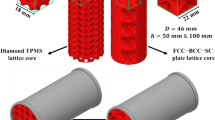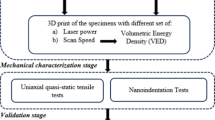Abstract
Associated with uneven heat transfer in molds, longitudinal off-corner depressions (LOCDs) have been identified as a general defect on wide–thick slabs during continuous casting. Additionally, the concurrent surface and subsurface cracks accompanying LOCDs consistently undermine the quality of high-end steel production. To control LOCDs and crack defects, a multibody and multifield coupling model is developed, upon which a convex-structure mold (CSM) is designed and optimized. In this work, the model is extended to cover the mold, secondary cooling zones, and reduction segments. Thus, the shell deformation can be described during the full process of continuous casting. Based on the model, the CSM is thoroughly compared with a traditional flat-plate mold (FPM) in terms of contact status, air gap expansion, interfacial heat transfer, shell growth, shell deformation, and LOCD formation. The results show that shell shrinkage in the FPM causes a larger contact gap at the corners. Consequently, thick slag layers and air gaps forming around shell corners lead to a hot (thin) spot at the wide face off-corner. With the corner gaps being closed in the CSM, the shell growth at the off-corner is homogenized, and the local hot spot disappears. In secondary cooling zones, the solidifying shell cast by the FPM undergoes larger deformation due to the thin spot. However, uniform shell growth in the CSM could avoid concentrated stress and increase the resistance to deformation. Therefore, the width and depth of the LOCD are greatly reduced throughout the continuous casting process. At the end of mechanical reduction, the depths of the LOCDs in the FPM and CSM cases are 1.77 and 1.1 mm, which correspond to heavy and slight defect levels, respectively. Through these numerical comparisons, the advantages of CSMs in controlling LOCDs are finally confirmed.


















Similar content being viewed by others
References
B.G. Thomas: Steel Res. Int., 2018, vol. 89, p. 1700312.
P. Presoly, R. Pierer, and C. Bernhard: Metall. Mater. Trans. A, 2013, vol. 44A, pp. 5377–88.
J.K. Brimacombe, F. Weinberg, and E.B. Hawbolt: Metall. Trans. B, 1979, vol. 10, pp. 279–92.
M.L.S. Zappulla and B.G. Thomas: Mater. Sci. Forum, 2018, vol. 941, pp. 112–17.
E. Wang and J. He: Sci. Technol. Adv. Mater., 2001, vol. 2, pp. 257–63.
W.R. Storkman, and B.G. Thomas:Modeling of Casting and Welding Processes, Palm Coast, FL, 1988, Minerals, Metals & Materials Society, Warrendale, PA, 1988, pp. 287–97.
P.H. Dauby: Rev. Métall., 2012, vol. 109, pp. 113–36.
B. Thomas and X. Huang: Metall. Trans. B, 1994, vol. 25B, pp. 527–47.
X. Huang and B.G. Thomas: Can. Metall. Q., 1998, vol. 37, pp. 197–212.
L. Xu, E. Wang, C. Karcher, A. Deng, and X. Xu: Metall. Mater. Trans. B, 2018, vol. 49B, pp. 2779–93.
S.M. Cho and B.G. Thomas: JOM, 2020, vol. 72, pp. 3610–27.
W.H. Lee and K.W. Yi: Met. Mater. Int., 2021, vol. 27, pp. 4168–81.
R.B. Mahapatra, J.K. Brimacombe, and I.V. Samarasekera: Metall. Mater. Trans. B, 1991, vol. 22B, pp. 875–78.
S. Pelak, R. Misicko, D. Fedáková, and J. Bidulská: Mater. Eng., 2009, vol. 16, pp. 21–28.
M.L.S. Zappulla, and B.G. Thomas:TMS 2017 146th Annual Meeting & Exhibition Supplemental Proceedings, San Diego, CA, USA, 2017, Springer Cham, 2017, pp. 501–10.
M.L.S. Zappulla: Mechanisms of Longitudinal Depression Formation in Steel Continuous Casting, Ph.D. Thesis, Colorado School of Mines, Ann Arbor, MI, 2020.
Y. Yashima: Tetsu-to-Hagane, 1984, vol. 70, p. S901.
B.G. Thomas, W.R. Storkman, and A. Moitra:Proc. 6th Int. Iron and Steel Congress, Nagoya, Japan, 1990, Iron and Steel Institute of Japan, Tokyo, 1990, pp. 348–55.
N. Yamasaki, S. Shima, K. Tsunenari, S. Hayashi, M. Doki, Y. Kato, D. Miki, and T. Nakanishi: Nippon Steel & Sumitomo Metal Technical Report, 2016, vol. 112, pp. 64–70.
S.V. Filatov, A.I. Dagman, V.N. Karavaev, V.P. Glebov, G.N. Kononykhin, A.B. Kotel’nikov, and A.A. Vopneruk: Metallurgist, 2018, vol. 62, pp. 58-61.
J. Yang and M. Zhu: ISIJ Int., 2016, vol. 56, pp. 2191–98.
J. Kim, S. Kim, D. Kim, Y. Lee, J. Eum, and E. Lee: Steelmaking Conference Proceedings, 1995, pp. 333–39.
C.B. Shi, M.D. Seo, J.W. Cho, and S.H. Kim: Metall. Mater. Trans. B, 2014, vol. 45B, pp. 1081–97.
C. Ji, Y. Cui, Z. Zeng, Z. Tian, C. Zhao, and G.-S. Zhu: J. Iron Steel Res. Int., 2015, vol. 22, pp. 53–56.
H. Cui, K. Zhang, Z. Wang, B. Chen, B. Liu, J. Qing, and Z. Li: Metals, 2019, vol. 9(2), p. 204.
W. Qian, L. Yongjian, H. Yuming, H. Bing, X. Yincheng, and Z. Jianguo: China Metall., 2012, vol. 22, pp. 22–27.
B.G. Thomas, A. Moitra, and R. McDavid: ISS Trans., 1996, vol. 23, pp. 57–70.
Z. Zhenyi, Z. Yongliang, and W. Kezhong: 2019 National Conference on Application of High Efficiency Continuous Casting Technology and Quality Control of Casting Billets, Yangzhou, 2019, Hebei Metals Society, pp. 241-44.
Y. Lu, Q. Wang, Y. Li, and S. He: Contin. Cast., 2011, vol. 2011, pp. 33–37.
Z. Niu, F. Du, J. Jiang, and H. Yu: Unpublished Research, Yanshan University, Qinhuangdao, Hebei, 2022.
Z. Niu, Z. Cai, and M. Zhu: Metall. Mater. Trans. B, 2021, vol. 52B, pp. 1556–73.
Z. Niu, Z. Cai, and M. Zhu: Metall. Mater. Trans. B, 2021, vol. 52B, pp. 2737–52.
Z. Niu, Z. Cai, and M. Zhu: ISIJ Int., 2019, vol. 59, pp. 283–92.
Z. Niu, Z. Cai, and M. Zhu: Ironmak. Steelmak., 2020, vol. 47, pp. 1135–47.
Z. Liu, B. Li, A. Vakhrushev, M. Wu, and A. Ludwig: Steel Res. Int., 2019, vol. 90, p. 1800117.
C. Wu, C. Ji, and M. Zhu: Metall. Mater. Trans. B, 2018, vol. 49B, pp. 1346–59.
S. Yu, M. Long, H. Chen, D. Chen, T. Liu, H. Duan, and J. Cao: Metall. Mater. Trans. B, 2018, vol. 49B, pp. 866–76.
Y. Meng and B.G. Thomas: Metall. Mater. Trans. B, 2003, vol. 34B, pp. 685–705.
Q. Qin, S. Shang, D. Wu, and Y. Zang: Adv. Mech. Eng., 2014, vol. 6, 942719.
X. Liu and M. Zhu: ISIJ Int., 2006, vol. 46, pp. 1652–59.
Z. Niu, Z. Cai, and M. Zhu: Ironmak. Steelmak., 2019, vol. 47, pp. 1–3.
M.L.S. Zappulla, G. Zhu, and B.G. Thomas: AISTech 2019—Proceedings of the Iron & Steel Technology Conference, 2019, pp. 6–9.
M.S.C. Marc: Theory and User Information, MSC Software Corporation, Newport Beach, 2016.
ANSYS: Fluent Theory Guide, ANSYS Inc., Canonsburg, PA, 2015.
MpCCI: Documentation, Fraunhofer Institute for Algorithms and Scientific Computing (SCAI), Sankt Augustin, Germany, 2015.
A. Yamanaka, K. Nakajima, and K. Okamura: Ironmak. Steelmak., 1995, vol. 22, pp. 508–12.
Y.M. Won, T.J. Yeo, D.J. Seol, and K.H. Oh: Metall. Mater. Trans. B, 2000, vol. 31B, pp. 779–94.
Acknowledgments
This work was financially supported by the National Natural Science Foundation of China (51975510).
Conflict of interest
On behalf of all authors, the corresponding author states that there are no conflict of interest.
Author information
Authors and Affiliations
Corresponding author
Additional information
Publisher's Note
Springer Nature remains neutral with regard to jurisdictional claims in published maps and institutional affiliations.
Rights and permissions
Springer Nature or its licensor (e.g. a society or other partner) holds exclusive rights to this article under a publishing agreement with the author(s) or other rightsholder(s); author self-archiving of the accepted manuscript version of this article is solely governed by the terms of such publishing agreement and applicable law.
About this article
Cite this article
Niu, Z., Du, F., Jiang, J. et al. A Novel Control Technique for Longitudinal Off-Corner Depressions on Wide Faces of Continuous Casting Slabs: Effect of the Mold Design on Controlling LOCDs. Metall Mater Trans B 54, 1900–1916 (2023). https://doi.org/10.1007/s11663-023-02803-7
Received:
Accepted:
Published:
Issue Date:
DOI: https://doi.org/10.1007/s11663-023-02803-7




